Sharon: Photographs of two sand dollars I found a few days ago, the larger was busted with a small hole just a little in the top center, and the "stars" were sitting inside, and I've shaken those out... nice photo op for close up magnification. The smaller sand dollar is intact. I'm anxiously awaiting getting photos of those, and identification of the species. From my shell book, it shows several sand dollars and the one favored most it is the "Florida Sand Dollar", unfortunately the author's note is class: Echinoidea, "many species", 1-4" which doesn't tell much.
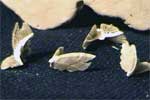
Click for large image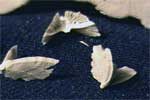
Click for large image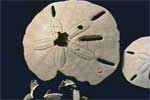
Click for large image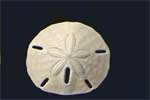
Click for large image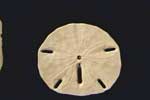
Click for large image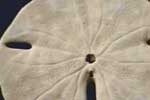
Click for large image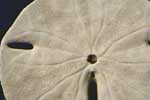
Click for large image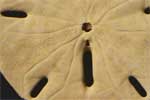
Click for large image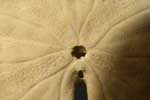
Click for large image
Click for large image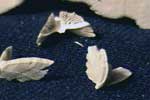
Click for large image
The "stars" that you found inside the sand dollar -- were there five of them, and were they shaped like "doves?" These are the five parts of the sand dollar mouth!
I'm sure you've seen the postcards and plaques with the broken sand dollar and the story of the 5 "doves" flying out of the exoskeleton.
I'm anxious to see your other photos -- love to see what you're finding down south!
Terri K. Hathaway
Marine Education Specialist
North Carolina Sea Grant
http://www.ncseagrant.org/
Sharon: There may have originally been 5, but I found the sand dollar with a hole already in it. I didn't know this was the mouth. --I shook 4 of those little doves out of it. (Thanks for the correction too.)
Do the doves "grind" the food, or do they sift small food particles from the water and absorb them?
Sally Thomas: The sand dollar is an Echinoderm as are sea stars, sea urchins, and sea cucumbers and have a hard internal skeleton... members of the phylum have five body sections arranged around a central axis. Most have hundreds of small tube feet, called podia, that work in unison, either to move the anumal over the bottom or to capture food. Sea urchins, sand dollars and sea biscuits specifically have centrally located mouth on the underside. The mouth is a complicated arrangement of five teeth, called Aristotle's Lantern, used for scraping algae and other organic food from rocks (urchins) or under the sand (sand dollars and sea biscuits). The Aristotle's Lantern remains inside the sand dollar which is flat and has a small mouth opening. It primarily grinds its food. Openings in the others are larger allowing the toothy A-L to protrude and scrape/collect food.
Sharon: After photographing the doves, I saw they *appear* they would be effective for straining food particles, but I am not completely sure about that, until I get an official answer from an expert.
Sally Thomas: Paul Humann's Reef Creature Identification Florida, Caribbean, Bahamas is a fine text that may interest you.
Terri Hathaway: I see you've already gotten some in-depth info on the sand dollars (or keyhole urchins) that you found. The scientific name is Mellita quiquiesperforata. The 5 holes are called lunules and may serve a couple of different purposes. They help prevent the living animals from being washed out of the sand (something to do with hydrodynamics of the water currents). And they help the sand move upwards as the animal buries itself.
Their 5 mouth parts form what's referred to as "Aristotle's lantern".
That's the 5 doves you hear rattling around in dead sand dollars.
When alive, they are covered with tiny brownish green spines that help the animal move and bury. Lots of things each sand dollars, including flounders and sea stars.
A couple of good references for sea creatures (including molluscs):
Nature Guide to the Carolina Coast by Peter Meyer
Seashore Animals of the Southeast by Edward E. Ruppert and Richard S. Fox
more later,
Terri K. Hathaway
Marine Education Specialist
North Carolina Sea Grant
http://www.ncseagrant.org/



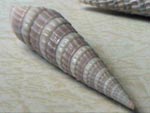

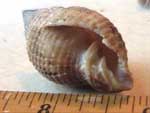





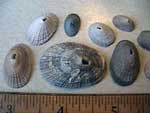

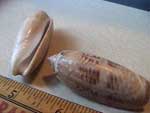
1 comment:
I was wondering if you knew whether or not you could break a dried and clean sand dollar and have a clean breat to get the doves out? I have some, but there are no holes except for the back where there is a large hole in the middle and one smaller near the outside of the dollar. I was thinking that I could soak one in salt water to soften. Any ideas?
Post a Comment